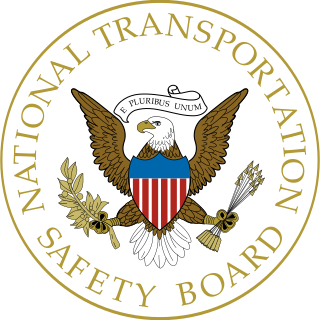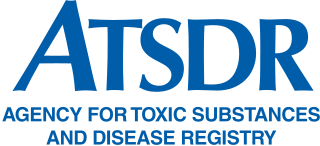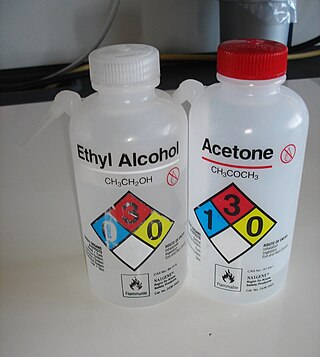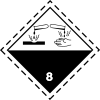
The National Transportation Safety Board (NTSB) is an independent U.S. government investigative agency responsible for civil transportation accident investigation. In this role, the NTSB investigates and reports on aviation accidents and incidents, certain types of highway crashes, ship and marine accidents, pipeline incidents, bridge failures, and railroad accidents. The NTSB is also in charge of investigating cases of hazardous materials releases that occur during transportation. The agency is based in Washington, D.C. It has four regional offices, located in Anchorage, Alaska; Denver, Colorado; Ashburn, Virginia; and Seattle, Washington. The agency also operates a national training center at its Ashburn facility.
A UN number is a four-digit number that identifies hazardous materials, and articles in the framework of international trade and transport. Some hazardous substances have their own UN numbers, while sometimes groups of chemicals or products with similar properties receive a common UN number. A chemical in its solid state may receive a different UN number than the liquid phase if its hazardous properties differ significantly; substances with different levels of purity may also receive different UN number

The Agency for Toxic Substances and Disease Registry (ATSDR) is a federal public health agency within the United States Department of Health and Human Services. The agency focuses on minimizing human health risks associated with exposure to hazardous substances. It works closely with other federal, state, and local agencies; tribal governments; local communities; and healthcare providers. Its mission is to "Serve the public through responsive public health actions to promote healthy and safe environments and prevent harmful exposures." ATSDR was created as an advisory, nonregulatory agency by the Superfund legislation and was formally organized in 1985.

A safety data sheet (SDS), material safety data sheet (MSDS), or product safety data sheet (PSDS) is a document that lists information relating to occupational safety and health for the use of various substances and products. SDSs are a widely used type of fact sheet used to catalogue information on chemical species including chemical compounds and chemical mixtures. SDS information may include instructions for the safe use and potential hazards associated with a particular material or product, along with spill-handling procedures. The older MSDS formats could vary from source to source within a country depending on national requirements; however, the newer SDS format is internationally standardized.

"NFPA 704: Standard System for the Identification of the Hazards of Materials for Emergency Response" is a standard maintained by the U.S.-based National Fire Protection Association. First "tentatively adopted as a guide" in 1960, and revised several times since then, it defines the "Safety Square" or "Fire Diamond" which is used to quickly and easily identify the risks posed by hazardous materials. This helps determine what, if any, special equipment should be used, procedures followed, or precautions taken during the initial stages of an emergency response. It is an internationally accepted safety standard, and is crucial while transporting chemicals.

The Incident Command System (ICS) is a standardized approach to the command, control, and coordination of emergency response providing a common hierarchy within which responders from multiple agencies can be effective.

Dangerous goods (DG), are substances that when transported are a risk to health, safety, property or the environment. Certain dangerous goods that pose risks even when not being transported are known as hazardous materials. An example for dangerous goods is hazardous waste which is waste that has substantial or potential threats to public health or the environment.

The Emergency Planning and Community Right-to-Know Act of 1986 is a United States federal law passed by the 99th United States Congress located at Title 42, Chapter 116 of the U.S. Code, concerned with emergency response preparedness.
Hazardous Waste Operations and Emergency Response is a set of guidelines produced and maintained by the Occupational Safety and Health Administration which regulates hazardous waste operations and emergency services in the United States and its territories. With these guidelines, the U.S. government regulates hazardous wastes and dangerous goods from inception to disposal.

Hazchem is a warning plate system used in Australia, Hong Kong, Malaysia, New Zealand, India and the United Kingdom for vehicles transporting hazardous substances, and on storage facilities. The top-left section of the plate gives the Emergency Action Code (EAC) telling the fire brigade what actions to take if there is an accident or fire. The middle-left section containing a 4 digit number gives the UN Substance Identification Number describing the material. The lower-left section gives the telephone number that should be called if special advice is needed. The warning symbol in the top right indicates the general hazard class of the material. The bottom-right of the plate carries a company logo or name.

The Hazardous Materials Identification System (HMIS) is a propritary numerical hazard rating that incorporates the use of labels with color bars developed by the American Coatings Association as a compliance aid for the OSHA Hazard Communication (HazCom) Standard. The name and abbreviation is a trademark of the American Coatings Association.

ORM-D was a marking for mail or shipping in the United States. Packages bearing this mark contained hazardous material in a limited quantity that present a limited hazard during transportation, due to its form, quantity, and packaging. ORM-D was phased out by the US Department of Transportation on January 1, 2021.
Right to know is a human right enshrined in law in several countries. UNESCO defines it as the right for people to "participate in an informed way in decisions that affect them, while also holding governments and others accountable". It pursues universal access to information as essential foundation of inclusive knowledge societies. It is often defined in the context of the right for people to know about their potential exposure to environmental conditions or substances that may cause illness or injury, but it can also refer more generally to freedom of information or informed consent.

The Pipeline and Hazardous Materials Safety Administration (PHMSA) is a United States Department of Transportation agency created in 2004, responsible for developing and enforcing regulations for the safe, reliable, and environmentally sound transportation of energy and other hazardous materials. It is in charge of overseeing about 3.4 million miles of pipelines - accounting for 65% of the energy consumed in the U.S. - and regulating the nearly 1 million daily shipments of hazardous materials by land, sea, and air. This includes pipelines carrying carbon dioxide Carbon capture and utilization). PHMSA's safety programs are housed in the Office of Pipeline Safety (OPS) and the Office of Hazardous Materials Safety (OHMS). PHMSA is headquartered in Washington, D.C.

The Center for Domestic Preparedness (CDP) is the only U.S. federal facility chartered to provide comprehensive preparedness training programs to the nation's emergency response providers. The facility, located in Calhoun County, Alabama, provides all-hazards training to approximately 50,000 emergency responders annually, or a total of 1.1 million responders since its inception in 1998. Trainees hail from state, local, tribal, territorial, and federal governments, as well as private entities. Training for state, local, tribal, and territorial governments are entirely funded by the United States Department of Homeland Security (DHS), whereas responders for foreign federal governments and private entities may be trained on a fee-for-service basis.
Wireless Information System for Emergency Responders (WISER) is a system to assist first responders in identification of hazardous materials during a response. The system was created by the United States National Library of Medicine. The system was discontinued in 2023.

Pesticide regulation in the United States is primarily a responsibility of the Environmental Protection Agency (EPA). In America, it was not till the 1950s that pesticides were regulated in terms of their safety. The Pesticides Control Amendment (PCA) of 1954 was the first time Congress passed guidance regarding the establishment of safe limits for pesticide residues on food. It authorized the Food and Drug Administration (FDA) to ban pesticides they determined to be unsafe if they were sprayed directly on food. The Food Additives Amendment, which included the Delaney Clause, prohibited the pesticide residues from any carcinogenic pesticides in processed food. In 1959, pesticides were required to be registered.
Operations Plus WMD is a training level in dealing with hazardous materials.

The Hazardous Materials Transportation Act (HMTA), enacted in 1975, is the principal federal law in the United States regulating the transportation of hazardous materials. Its purpose is to "protect against the risks to life, property, and the environment that are inherent in the transportation of hazardous material in intrastate, interstate, and foreign commerce" under the authority of the United States Secretary of Transportation.
















